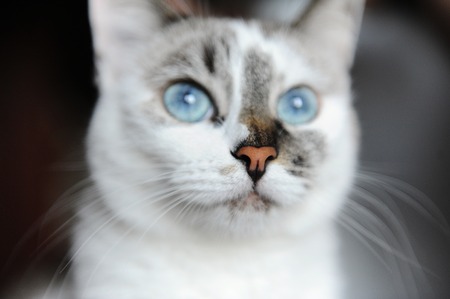1. Changes in Eating and Drinking Habits
As a cat owner, keeping an eye on your feline friends eating and drinking habits is crucial. Sudden changes in appetite or water intake can be early indicators of underlying health problems.
Loss of Appetite
If your cat suddenly stops eating or shows a significant decrease in food consumption, it could signal various health issues, such as dental problems, digestive disorders, or even more serious conditions like kidney disease or cancer.
Increased Thirst
Cats naturally have a low thirst drive, so if you notice your cat drinking more water than usual, it might be a sign of diabetes, kidney disease, or other medical concerns. Monitor their water intake and consult a vet if the change persists.
When to Be Concerned
| Behavior | Possible Health Concerns |
|---|---|
| Refusing to eat for over 24 hours | Dental issues, gastrointestinal problems, serious illness |
| Drinking excessive amounts of water | Diabetes, kidney disease |
| Sudden weight loss despite normal eating | Hyperthyroidism, diabetes, cancer |
What You Can Do
If you notice changes in your cat’s eating or drinking habits, observe them closely and take note of any additional symptoms. A quick visit to the vet can help identify the cause early and ensure your cat stays healthy.
2. Unusual Behavior or Mood Changes
Cats are creatures of habit, and any sudden shift in their behavior could be a sign that something is wrong. If your usually social cat becomes withdrawn, aggressive, or lethargic, it may be a sign of discomfort or illness that requires veterinary attention.
Signs to Watch For
Changes in mood and behavior can manifest in different ways. Here are some common signs that indicate your cat may not be feeling well:
| Behavior Change | Possible Concern |
|---|---|
| Avoiding interaction or hiding more than usual | Pain, stress, or underlying illness |
| Unusual aggression or irritability | Discomfort, pain, or neurological issues |
| Lethargy or lack of interest in activities they once enjoyed | Sickness, fever, or fatigue from an underlying condition |
| Sudden vocalization changes (more meowing or unusual silence) | Pain, anxiety, or cognitive decline |
| Pacing, restlessness, or inability to settle down | Anxiety, discomfort, or internal distress |
When to Call the Vet
If these behavioral changes persist for more than a day or two, it’s important to consult your veterinarian. Cats often hide their pain, so even subtle shifts in behavior can be an early warning sign of a health issue.
Tips for Monitoring Your Cat’s Behavior
- Create a Routine: Keep track of your cat’s daily habits to notice changes more easily.
- Observe Social Interactions: Take note if your cat suddenly avoids family members or other pets.
- Monitor Energy Levels: If your cat is sleeping excessively or avoiding playtime, it could indicate an issue.
- Listen to Vocal Cues: Sudden excessive meowing or complete silence can be a red flag.
- Keeps a Journal: Writing down any changes in behavior can help you provide accurate details to your vet.
Your cat’s behavior is one of the clearest indicators of their overall health. Paying attention to mood changes and unusual actions can help you catch potential health problems before they become serious.

3. Respiratory Issues and Coughing
If your cat is sneezing frequently, coughing, or having trouble breathing, it could be a sign of an underlying health issue. Respiratory problems in cats can range from mild allergies to serious infections or chronic conditions like asthma. Recognizing these symptoms early can help ensure your cat gets the care they need.
Common Respiratory Symptoms in Cats
| Symptom | Possible Cause |
|---|---|
| Frequent sneezing | Allergies, viral infections (like feline herpesvirus) |
| Coughing or wheezing | Asthma, respiratory infections, heart disease |
| Nasal discharge | Bacterial infections, fungal infections |
| Labored or rapid breathing | Pneumonia, fluid buildup in the lungs |
When to Be Concerned
If your cat has occasional sneezing but is otherwise acting normal, it may not be a major concern. However, you should contact your vet if you notice:
- Persistent coughing or wheezing that lasts more than a day.
- Difficult or rapid breathing (especially if your cat is open-mouth breathing).
- Nasal discharge that is thick, yellow, green, or bloody.
- Lethargy or loss of appetite along with respiratory symptoms.
How to Help Your Cat at Home
If your cat has mild respiratory symptoms but is still eating and active, you can try the following:
- Create a humid environment: A humidifier or steaming up the bathroom can help clear nasal passages.
- Keep their nose clean: Use a soft cloth to wipe away any discharge gently.
- Avoid irritants: Dust, cigarette smoke, and strong fragrances can worsen respiratory issues.
If symptoms persist or worsen, its best to seek veterinary care immediately to rule out serious conditions like pneumonia or asthma.
4. Digestive Problems
Your cat’s digestive health is a good indicator of their overall well-being. Occasional stomach issues can happen, but persistent problems should never be ignored.
Signs to Watch For
If your cat experiences vomiting, diarrhea, or constipation for more than a day, it could be a sign of an underlying issue. These symptoms may point to food allergies, infections, or even more serious gastrointestinal conditions.
Possible Causes
| Symptom | Possible Cause |
|---|---|
| Frequent Vomiting | Food allergies, hairballs, infections, or kidney disease |
| Diarrhea | Bacterial infections, parasites, diet changes, or stress |
| Constipation | Lack of fiber, dehydration, or intestinal blockage |
When to See a Vet?
If your cat’s digestive issues last more than 24 hours, it’s best to consult your vet. Dehydration from prolonged vomiting or diarrhea can become dangerous quickly. If you notice blood in their stool or vomit, or if they stop eating altogether, seek veterinary care immediately.
How to Help at Home
- Monitor their diet: Sudden food changes can upset their stomach.
- Keep them hydrated: Encourage drinking water to prevent dehydration.
- Avoid human food: Some ingredients can cause digestive distress.
- Add fiber if needed: Pumpkin puree can help with mild constipation.
Your cat’s digestive health is crucial for their overall happiness and well-being. Paying attention to early signs of trouble can help prevent more serious health issues down the road.
5. Changes in Grooming and Appearance
Cats are known for their meticulous grooming habits. If you notice any changes in how your cat takes care of its fur, it could be a sign that something is wrong. Paying attention to your cats coat and grooming behavior can help you catch early signs of illness.
Signs to Watch For
Changes in grooming habits can manifest in different ways. Below are some common signs that may indicate a health issue:
| Sign | Possible Cause |
|---|---|
| Excessive grooming | Skin irritation, allergies, stress, or pain |
| Hair loss or bald patches | Fleas, allergies, infections, or underlying disease |
| Dull or greasy coat | Poor nutrition, dehydration, or illness |
| Neglecting grooming altogether | Arthritis, obesity, dental pain, or general discomfort |
Why Grooming Changes Matter
If your cat is overgrooming to the point of hair loss, it might be due to stress or skin problems. On the other hand, if your cat stops grooming entirely, it could be experiencing pain or mobility issues. A healthy cat should have a clean and shiny coat; any noticeable decline in fur quality should not be ignored.
What You Can Do
- Check for fleas, dandruff, or skin irritation.
- Make sure your cat is eating a balanced diet with enough hydration.
- If your cat seems unable to groom properly, schedule a vet check-up to rule out pain or illness.
- Reduce stressors in your home that may be causing excessive grooming.
Your cat’s coat condition is often a reflection of its overall health. By keeping an eye on any changes in grooming habits and appearance, you can catch potential health issues early and ensure your feline friend stays happy and comfortable.
6. Unusual Litter Box Behavior
Cats are usually very particular about their litter box habits, so any sudden changes could be a sign of an underlying health issue. If your cat is urinating more frequently, struggling to urinate, or going outside the litter box, it might indicate a medical problem that needs attention.
Possible Health Issues
Changes in litter box behavior can be linked to several health conditions. Below are some common issues associated with unusual urination patterns:
| Behavior | Possible Causes |
|---|---|
| Frequent urination | Urinary tract infection (UTI), diabetes, kidney disease |
| Straining to urinate | Bladder stones, urinary blockage, inflammation |
| Peeing outside the litter box | Stress, arthritis, UTI, territorial marking |
| Painful or vocalizing while urinating | Cystitis, bladder infection, urinary obstruction |
When to See a Vet
If your cat is experiencing any of these symptoms, its essential to consult a veterinarian as soon as possible. Urinary blockages, especially in male cats, can become life-threatening if not treated quickly. Additionally, infections and other issues can cause discomfort and long-term health complications if left unaddressed.
What You Can Do at Home
- Monitor their habits: Keep track of how often your cat uses the litter box and any signs of discomfort.
- Ensure proper hydration: Encourage your cat to drink more water by providing fresh water sources or using a pet fountain.
- Litter box cleanliness: A clean litter box can prevent stress-related avoidance and reduce the risk of infections.
- Dietary adjustments: Wet food or special urinary health diets may help prevent certain urinary issues.
The Importance of Early Detection
Catching these signs early can prevent serious health problems down the road. Regularly observing your cat’s behavior and maintaining a clean and comfortable litter box environment can go a long way in keeping them happy and healthy.


